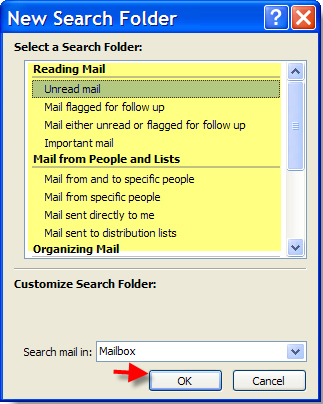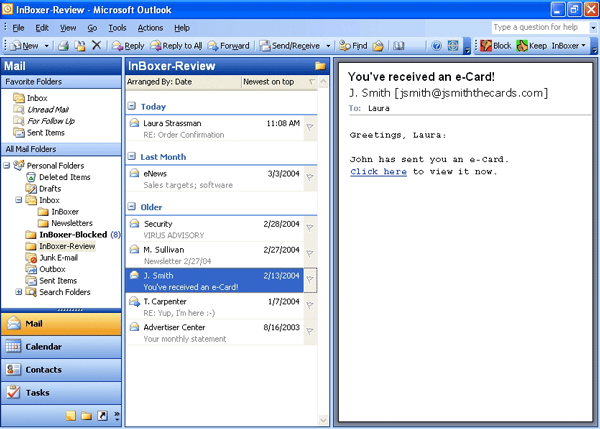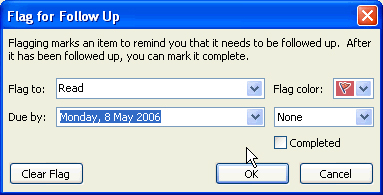7 ways to filter, classify and search effective email
QuanTriMang - A messy, unorganized mailbox will make it difficult for users to find the necessary email. However, you can still remedy this situation. Microsoft Outlook provides great tools that help users filter emails and organize messages in a more manageable and meaningful way. Outlook even helps increase efficiency and performance for users. Whether you're using Outlook 2010, Outlook 2007 or Outlook 2003, you can easily manage your email.
You are using Outlook Express, or other email applications such as Windows Live Mail or Windows Live Hotmail. These software also offer many of the same features as those mentioned in this article. However, they do not provide the same tools for managing email. Use Microsoft Office Outlook Hotmail Connector to add Hotmail accounts to Outlook, then you can use the tips below to organize your Hotmail account. Or, users can carefully read Hotmail's features to organize information on Hotmail systems. For example, you can merge email from different email accounts, such as Gmail and Yahoo! Mail. From there, users can receive, read and reply to all emails from a single place.
Users can use one or more of the tools included in this article to collapse your Inbox and make it easy to find the information you need.
1. Quickly filter messages
Outlook 2010 has a great new feature to organize messages by date and arrange them by Conversation. Using this feature, messages with the same topic will appear as Conversations and users can view, expand or minimize them by clicking on the icon on the left of the Subject line. Messages inside each Conversations are categorized with the latest message placed on the head. When a new message is received, all Comversation moves to the top of the email list, making it easier to follow email streams.

To activate Conversations, on the View tab, in the Conversations group, check the Show as Conversations dialog box. You can reduce the size of a Conversation with the Clean Up feature. This feature will help delete duplicate messages in Conversation . On the Home tab, in the Delete group, click Clean Up , and click on Clean Up Conversation .
In all versions of Outlook, users can find messages in the mailbox folder faster by changing the way they are classified in the email folder. For example, you can sort emails by date, sender, file size or importance level.
2. Group the same messages into folders
By creating a new email folder, users can group related messages into the folder. For example, you can group messages by topic, project, contact or other categories that match your work or interests. Users even create folders for all messages sent from your boss or someone else important, including important information to save.
- To create a new folder in Outlook 2010, on the Folder tab, in the New group, click New Folder .
- To create a new folder in Outlook 2007 or Outlook 2003, click the File → New → Folder menu .
3. Create a search folder to find messages faster
Search Folders is a quick and handy way to find a collection of email messages. They do not save any messages, but instead are virtual folders that provide a display of all the messages in your mailbox based on the attributes the user wants to search for. Outlook provides the default Search Folders feature - such as Unread Mail - but can also create its own rule. For example, you can use Search Folders to help find all the information related to a certain project, an important customer or an upcoming meeting.
- To create a Search Folder in Outlook 2010, in Mail , on the Folder tab, in the New group, click New Search Folder .
- To create a Search Folder in Outlook 2007 or Outlook 2003, in Mail , on the File menu, move your mouse to New , and then click Search Folder .

In all versions of Outlook, determine whether you want to use the previously created Search Folder or create a folder for yourself, then follow the on-screen instructions.
4. Effective email routing by using rules
By creating a rule for Outlook, you can automatically perform actions for both incoming and outgoing email messages based on previously established criteria. For example, users can automatically forward to their superiors all messages sent from someone right after the message 'docked', assign the Sales item to all sent messages containing the word 'sales'. in the Subject line. Effective email routing not only helps organize email, but it also saves time when doing some small tasks.
5. Reduce email with junk file filter
Keep unnecessary email messages out of Inbox using the Outlook Junk Email filter. These filters send email flagged as junk files to a separate email folder in the mailbox. Users can view the contents of this folder to ensure that no valid email is mistakenly sent there. If so, you should adjust the filter to avoid misidentifying these messages in the future.

6. Assign a color list
Assign a color entry to a group of unrelated email messages and other items in Outlook, such as notes, contacts and appointments. From there, users can easily identify and organize them. For example, you can easily track all messages, appointments, and contacts for your project by creating a category called Project Quantrimang and assigning items to it.
7. Flag for follow up
Users can use the Flag for Follow Up feature to flag messages and tasks to help sort them or mark them. Flags will prompt you to follow a problem, indicate someone's request or set a reminder for a message, contact. They can also sort email folders very easily because you know exactly what to do and when to do. Note that when a user creates a task and sets an expiration date for that task, the task is automatically flagged so that you do not forget the expiration date of the task and complete it well.

You should read it
- 6 ways to work faster in MS Outlook
- Assign Background image to email in Outlook
- 4 ways to manage email effectively
- Add Hotmail and Live Email accounts to Outlook 2010
- What is Outlook Mail? How to register and use Outlook mail for beginners
- All you need to know about Outlook Express on Windows 10
- The best options replace Microsoft Outlook
- Summary of useful keyboard shortcuts when using Microsoft Outlook on the web
May be interested
- Instructions for setting up Mozilla Thunderbird to set up email scheduling and automatic mail replies
 the need to write an email reply with too many content makes you spend a lot of time or you want to send an email in the future but are afraid to forget what to do? quite simply, the following article will guide readers to set up email delivery schedules and set up automatic mail replies in mozilla thunderbird.
the need to write an email reply with too many content makes you spend a lot of time or you want to send an email in the future but are afraid to forget what to do? quite simply, the following article will guide readers to set up email delivery schedules and set up automatic mail replies in mozilla thunderbird. - Instructions for creating incoming mail filters on Gmail
 if you use gmail as the main exchange method, especially for those who use to exchange jobs, the number of new emails is quite large. therefore, we should have a tool to effectively manage all emails sent on gmail.
if you use gmail as the main exchange method, especially for those who use to exchange jobs, the number of new emails is quite large. therefore, we should have a tool to effectively manage all emails sent on gmail. - How to filter data in Excel
 your excel spreadsheet has a lot of data, so it's easy to process and search the data in your table. filter data by conditions, criteria you give, you will shorten the search time and data processing
your excel spreadsheet has a lot of data, so it's easy to process and search the data in your table. filter data by conditions, criteria you give, you will shorten the search time and data processing - This is the most effective way to search on google
 do you know how to use the best google search engine today? with just a few simple tips, you will get the best results when using this search system.
do you know how to use the best google search engine today? with just a few simple tips, you will get the best results when using this search system. - How to create filters in Gmail to classify messages?
 creating filters in gmail helps you sort and manage your mail more quickly, you should create filters suitable for each purpose of the mail. if you do not know how to create a filter in gmail, please follow the instructions in the article below.
creating filters in gmail helps you sort and manage your mail more quickly, you should create filters suitable for each purpose of the mail. if you do not know how to create a filter in gmail, please follow the instructions in the article below. - Instructions for using filters in Yahoo Mail
 most people think that filtering in email programs is simply to prevent spam. not only that, the filter can also be used to help users manage very useful email messages.
most people think that filtering in email programs is simply to prevent spam. not only that, the filter can also be used to help users manage very useful email messages. - Guide to Automatic Filter and Filter detailed data in excel
 to search and create small data tables that meet some conditions as required into big tables, we have to filter those data.
to search and create small data tables that meet some conditions as required into big tables, we have to filter those data. - Learn to write email like a real CEO
 if you want to impress employers by email for job or want to practice effective email writing skills, then learn how to write a leader's email.
if you want to impress employers by email for job or want to practice effective email writing skills, then learn how to write a leader's email. - Photoshop CS: Eclipse effect
 in the previous article, i showed you how to create a color swirl using a few effects from the filter filter. there will be many more interesting things from this filter filter that make sure
in the previous article, i showed you how to create a color swirl using a few effects from the filter filter. there will be many more interesting things from this filter filter that make sure - 29 ways to end popular English emails and their meanings
 here are 29 common email ending ways and the meaning of each way so you can know when to use, when to avoid and how to use it when you're not sure. invite you to consult!
here are 29 common email ending ways and the meaning of each way so you can know when to use, when to avoid and how to use it when you're not sure. invite you to consult!










 Manage spam from practical experience
Manage spam from practical experience 10 great tools of Microsoft Word
10 great tools of Microsoft Word Customize bulk messages in Gmail
Customize bulk messages in Gmail These helpful tips when using email
These helpful tips when using email Extract images from Office documents quickly
Extract images from Office documents quickly 5 useful add-ins for Word 2010
5 useful add-ins for Word 2010